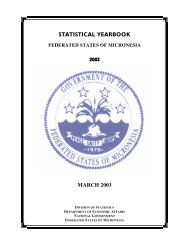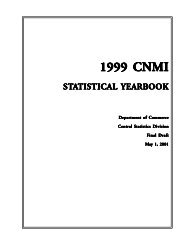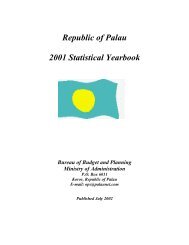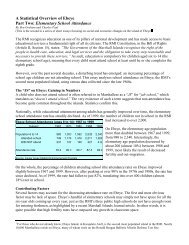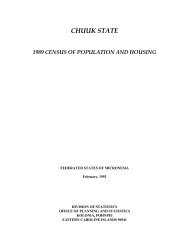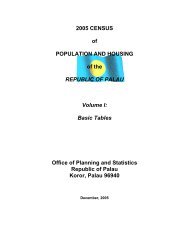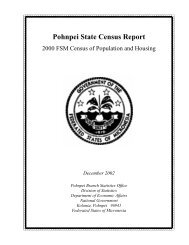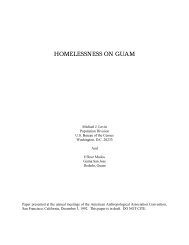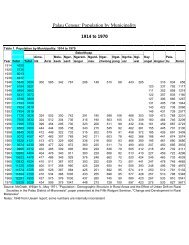Chuuk State Census Report - pacificweb.org
Chuuk State Census Report - pacificweb.org
Chuuk State Census Report - pacificweb.org
You also want an ePaper? Increase the reach of your titles
YUMPU automatically turns print PDFs into web optimized ePapers that Google loves.
Chapter 4. Fertility2000 FSM <strong>Census</strong> of <strong>Chuuk</strong> <strong>State</strong>education had on average 2.9 children. Interestingly, women with no schooling had lower fertility than those womenwith elementary education. This finding is common because some education often increases a woman's awareness ofpre-natal care thus improves her health status and ability to bear children. Additionally, between 1994 and 2000 theTFR declined all the education level except for “no school” category.Table 4.7: Children Ever Born per Woman and TFR by Mother's Educational Attainment, <strong>Chuuk</strong> <strong>State</strong>: 1994 and 20001994 2000No Elem- High H.S. Some College No Elem- High H.S. Some CollegeAge groups Total school entary school graduates college graduates Total school entary school graduates college graduates15 to 19 years 0.086 0.141 0.113 0.04 0.141 0.115 - 0.075 0.174 0.099 0.051 0.077 0.022 0.37520 to 24 years 0.651 0.934 0.891 0.645 0.308 0.234 - 0.630 0.866 0.896 0.632 0.377 0.288 0.20025 to 29 years 2.042 2.471 2.46 2.237 1.292 0.981 0.333 1.586 1.823 1.901 1.730 1.206 0.845 0.61330 to 34 years 3.664 3.969 3.852 3.949 3.234 2.751 1.952 3.072 3.498 3.559 3.137 2.455 1.694 1.12935 to 39 years 5.061 5.231 5.837 5.342 4.263 3.852 3.484 4.443 4.253 4.868 4.758 3.764 3.143 2.40440 to 44 years 6.279 6.504 6.727 6.286 5.816 4.93 3.667 5.575 5.253 6.237 5.840 5.190 4.782 3.85345 to 49 years 6.734 6.762 7.125 7.073 5.433 5.689 2.733 6.238 6.773 6.916 5.674 5.303 4.345 4.000TFR 4.35 4.58 4.69 4.51 4.29 3.10 2.80 3.84 4.73 4.47 3.93 2.86 2.23 2.52Source: 1994 FSM <strong>Census</strong>, Table P102; 2000 FSM <strong>Census</strong>, Table P4-3.Another determinant of fertility was whether a mother was in the labor force or not. Table 4.8 presents a comparison ofthe 1994 and 2000 data on fertility rates for women who were in the labor force, employed or unemployed, and thosenot in the labor force. As would be expected, in both years, those women who were in the labor force had lowerfertility levels (TFR of 3.4) than the women who were not in the labor force (TFR of 4.5), probably because womenwho had children in the year before the census took themselves out of the labor force to care for their child. Within thelabor force, women working full time (35+ hours) had the lowest fertility rates. Women who were looking for work (orunemployed) had higher fertility rates.Table 4.8: Children Ever Born per Woman and TFR by Labor Force Participation, <strong>Chuuk</strong> <strong>State</strong>: 1994 and 20001994 2000In the labor force (LF) Not in In the labor force Not inAll Total Employed Unem- labor Total Employed Unem- laborAge groups women in LF Total 35+ hours ployed force women in LF Total 35+ hours ployed force15 to 19 years 0.086 0.092 0.109 0.122 0.087 0.085 0.075 0.128 0.073 0.148 0.170 0.05420 to 24 years 0.651 0.524 0.553 0.407 0.503 0.708 0.630 0.594 0.574 0.239 0.610 0.67725 to 29 years 2.042 1.526 1.347 1.160 1.761 2.286 1.586 1.462 1.359 0.893 1.582 1.76830 to 34 years 3.664 3.258 3.039 2.804 3.649 3.840 3.072 2.946 2.943 1.794 2.951 3.27135 to 39 years 5.061 4.432 4.272 4.014 4.795 5.427 4.443 4.350 4.363 3.825 4.327 4.60540 to 44 years 6.279 5.713 5.413 5.247 6.326 6.595 5.575 5.467 5.518 4.380 5.309 5.73245 to 49 years 6.734 6.322 6.130 6.273 6.808 6.915 6.238 6.083 6.055 4.636 6.172 6.458TFR 4.35 3.50 3.45 3.15 3.57 4.78 3.84 3.47 3.31 2.57 3.59 4.51Source: 1994 FSM <strong>Census</strong>, Table P134; 2000 FSM <strong>Census</strong>, Table P9-3.Finally, fertility differentials by region are considered in Table 4.9. The reported age specific fertility rate was usedto assess the differentials in current level of fertility. Faichuk had the highest fertility rates in both 1994 and 2000.Mortlocks had the lowest fertility rates for both censuses. In both years Faichuk had higher fertility rates at theyounger and older ages, suggesting the absence of family planning. The relatively lower level of fertility for theMortlocks could be the result of more females enrolled in school and delay in marriage. In both years, fertilitypeaks at ages 25-29 or 30-34 in all the regions.Table 4.9: Age-specific Fertility Rates by Region, <strong>Chuuk</strong> <strong>State</strong>: 1994 and 20001994 2000Age groups Total N. Namon. S. Namon. Faichuk Mortlocks Oksoritod Total N. Namon. S. Namon. Faichuk Mortlocks Oksoritod15 to 19 years 0.026 0.023 0.024 0.044 0.021 0.007 0.028 0.018 0.036 0.023 0.033 0.04720 to 24 years 0.126 0.127 0.123 0.134 0.117 0.127 0.139 0.136 0.125 0.159 0.149 0.11525 to 29 years 0.194 0.185 0.182 0.225 0.133 0.250 0.187 0.182 0.253 0.191 0.106 0.17230 to 34 years 0.202 0.175 0.189 0.232 0.211 0.243 0.183 0.175 0.200 0.214 0.132 0.16035 to 39 years 0.160 0.146 0.151 0.189 0.151 0.173 0.137 0.121 0.168 0.169 0.122 0.07840 to 44 years 0.119 0.107 0.138 0.178 0.058 0.042 0.070 0.060 0.078 0.107 0.039 0.04645 to 49 years 0.040 0.051 0.030 0.059 0.008 0.034 0.024 0.020 0.021 0.045 0.013 0.009TFR 4.35 4.07 4.19 5.30 3.49 4.38 3.84 3.56 4.40 4.54 2.97 3.13Source: 1994 and 2000 FSM <strong>Census</strong>es, Unpublished dataChildren ever born per woman provide an estimate of how many children a woman is likely to have had by the time shehas reached a specified age group. This measure does not reflect current fertility, except for the youngest age group.40 <strong>Chuuk</strong> Branch Statistics Office, Division of Statistics, FSM Department of Economic Affairs



